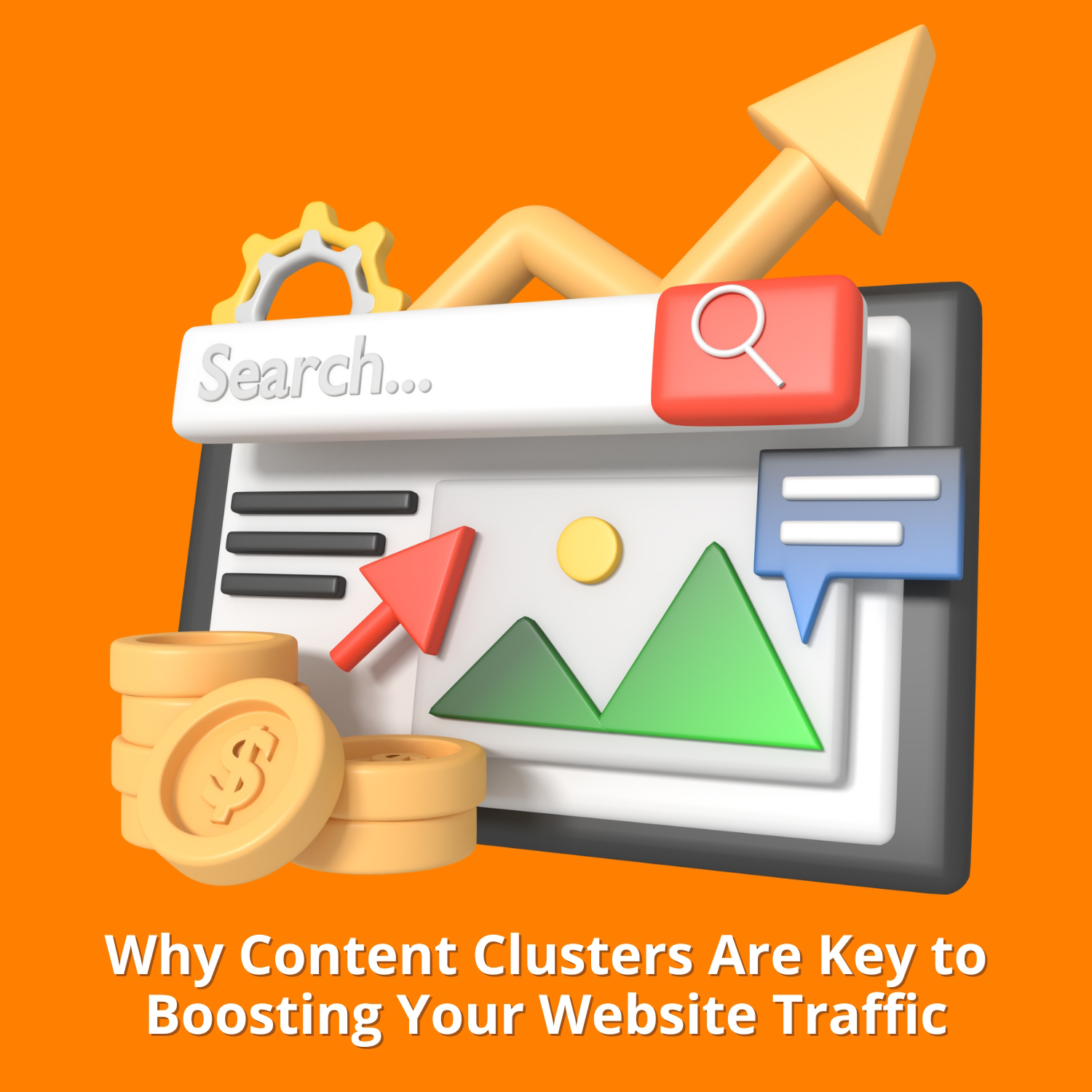Why Content Clusters Are Key to Boosting Your Website Traffic
In the ever-evolving world of digital marketing, one of the most effective strategies to boost website traffic is organizing content in a way that enhances SEO and improves user experience. One such strategy gaining traction is the concept of content clusters.
Content clusters are a method of grouping related content together under a broad topic, with a central pillar page linking out to smaller, topic-specific pages. This method is not only beneficial for search engines but also for users, as it provides a clear, easy-to-navigate structure that answers their queries. In this blog, we’ll explore why content clusters are crucial for increasing your website traffic, how they work, and how you can implement them effectively.
What Are Content Clusters?
Content clusters refer to a set of interlinked pages centered around a particular broad topic or “pillar page.” The pillar page is typically a comprehensive, long-form piece of content that covers a core topic in-depth. It links to smaller, more specific content pieces (also known as cluster content) that explore subtopics of the main subject in detail. These cluster pages, in turn, link back to the pillar page, creating a well-organized content ecosystem.
For example, if your website focuses on fitness, your pillar page might cover “Complete Guide to Fitness and Wellness,” while your cluster pages might cover topics like “Yoga for Beginners,” “Benefits of Weight Training,” and “Best Nutrition for Weight Loss.” All of these cluster pages link back to the main pillar page, signaling to search engines that they are all related.
The Importance of Content Clusters for SEO
Content clusters have gained popularity because they align perfectly with how search engines, like Google, rank content. Here’s why they are so important for SEO:
1. Improved Keyword Targeting
When you structure your content around a central topic, it becomes easier to target a wide range of related keywords. The pillar page targets a broad, high-volume keyword, while each cluster page focuses on more specific long-tail keywords. For instance, if your pillar page targets the keyword “fitness,” your cluster pages could target keywords like “home workouts,” “gym training,” or “fitness diet.” By covering these related topics, you create a strong network of content that helps your site rank for a variety of relevant search terms.
2. Enhanced Crawlability
Search engines use web crawlers to index content on the internet. Content clusters make it easier for crawlers to navigate and index your website by providing a clear, logical structure. The interlinking between your pillar page and cluster pages creates a “link juice” flow, which helps search engines understand the relationships between your pages. This structure allows Google to crawl your site more efficiently and rank your pages higher.
3. Boosting Authority with Internal Linking
By linking your cluster pages to your pillar page, and vice versa, you create an internal linking strategy that helps build domain authority. Internal links tell search engines which pages on your website are the most important. When you link your cluster content to the pillar page, you signal to search engines that the pillar page is authoritative and should rank higher. Additionally, the more internal links you have, the more traffic you can drive to your core pages, helping to boost overall SEO performance.
4. Increased Dwell Time and Engagement
Content clusters not only help search engines but also benefit users. By grouping related content together, you make it easier for visitors to find answers to their questions without having to leave your site. This improves the user experience and encourages them to spend more time exploring your content. As a result, your site’s dwell time (how long visitors stay on your page) increases, which is a positive ranking factor for search engines.
5. Supporting Featured Snippets
Content clusters increase your chances of appearing in featured snippets—the boxed information that appears at the top of Google’s search results. When your cluster pages target specific questions related to your pillar topic, you’re more likely to provide concise, well-structured answers that can be featured in the snippet. For example, if your pillar page is about “Fitness,” a cluster page on “How to Lose Belly Fat” could show up in the featured snippet for that query.
How to Build Content Clusters
Now that we understand the importance of content clusters for boosting website traffic and SEO, let’s look at how to build them effectively.
1. Identify Your Pillar Topic
The first step in building a content cluster is identifying your pillar topic. This topic should be broad enough to encompass a wide range of related subtopics but also specific to your niche. Think of a topic that is central to your industry or the products and services you offer. It should be a keyword with high search volume and relevance to your target audience.
For example, if you run a blog about digital marketing, your pillar page could cover a broad topic like “Complete Guide to Digital Marketing.” This topic allows you to branch out into various subtopics such as “SEO for Beginners,” “Social Media Marketing Strategies,” and “Email Marketing Tips.”
2. Conduct Keyword Research
Keyword research is essential for building content clusters. You need to identify both high-volume keywords for your pillar page and long-tail keywords for your cluster content. Use keyword research tools like Google Keyword Planner, Ahrefs, or SEMrush to find relevant keywords.
For example, if your pillar page is about “digital marketing,” some potential cluster topics could include “content marketing,” “SEO tips,” “email marketing best practices,” and so on. These topics should each target specific long-tail keywords, ensuring that your content is optimized for a variety of search terms.
3. Create the Pillar Page
Your pillar page is the cornerstone of your content cluster. It should provide a comprehensive, high-level overview of the main topic and serve as a gateway to the more detailed cluster pages. A good pillar page is long-form (at least 1,500 to 2,000 words), informative, and structured for readability.
Make sure to include internal links to your cluster pages within the pillar content. These links should point to your subtopic pages, helping both users and search engines easily navigate your site. The more well-structured and content-rich your pillar page is, the better its chances of ranking for the broad topic.
4. Create Cluster Content
Once your pillar page is live, it’s time to build out your cluster content. Each cluster page should focus on a specific aspect of the pillar topic, offering detailed, in-depth information. These pages should be optimized for long-tail keywords and provide value to your audience by answering their specific questions.
For instance, if your pillar page is about digital marketing, your cluster content could include articles like “How to Improve Your SEO Strategy” or “The Best Content Marketing Tools.” Each of these pages should link back to your pillar page and to other related cluster content, forming a network of interconnected, relevant pages.
5. Optimize for SEO
To make your content clusters as effective as possible, you need to optimize your pillar and cluster pages for SEO. This includes using relevant keywords, optimizing meta tags, adding alt-text for images, and ensuring your content is mobile-friendly.
Additionally, make sure your content is easy to read and structured for the web. Use subheadings, bullet points, and short paragraphs to break up the text. Search engines reward content that is user-friendly and well-optimized, so prioritize these factors when creating your content.
6. Promote and Update Your Content
Once you’ve created your pillar and cluster content, it’s time to promote it. Share your posts on social media, email newsletters, and any other platforms where your audience hangs out. The more exposure your content gets, the more likely it is to drive traffic to your website.
Additionally, regularly update your content to keep it relevant. Search engines favor fresh, up-to-date content, so make sure to revisit your pillar and cluster pages periodically and update them with new information, links, or multimedia.
Conclusion
Content clusters are a powerful strategy for boosting your website traffic, improving SEO, and enhancing the user experience. By organizing your content around a central pillar page and related cluster pages, you create a well-structured content ecosystem that benefits both search engines and users. This approach increases your chances of ranking for a wide range of relevant keywords, builds domain authority, and drives more organic traffic to your site.










